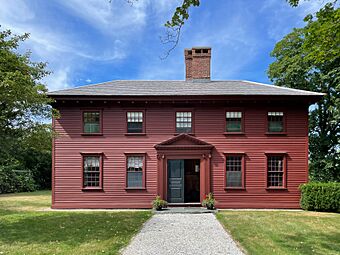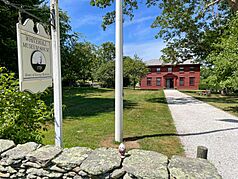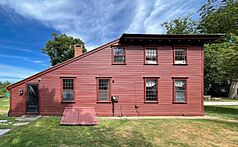Whitehall Museum House facts for kids
Quick facts for kids |
|
|
Whitehall
|
|

Whitehall Museum House in 2022
|
|
| Location | Berkeley Ave., Middletown, Rhode Island |
|---|---|
| Built | 1729 |
| Architectural style | Georgian |
| NRHP reference No. | 70000016 |
| Added to NRHP | April 28, 1970 |
The Whitehall Museum House is a historic farmhouse in Middletown, Rhode Island. It was once the home of Dean George Berkeley, a famous Irish thinker. He lived there from 1729 to 1731. Berkeley was planning to open a college in Bermuda at the time. The house is also called Berkeley House or Bishop George Berkeley House. It became a protected historic place in 1970.
Contents
History of Whitehall
George Berkeley's Arrival
George Berkeley (1685–1753) was a well-known philosopher. He arrived in Newport, Rhode Island, on January 23, 1729. A local minister, Reverend James Honyman, welcomed Berkeley and his group. He invited them to stay at his home.
Buying the Farm
In February 1729, Berkeley bought a farm. It was about 96 acres (39 hectares) and had a small house. The farm was next to Reverend Honyman's property. Berkeley made the house bigger to fit his needs. He named it "Whitehall." This name was a tribute to the palace of English Kings.
Life at Whitehall
Berkeley lived in Whitehall for about two years. During this time, he wrote his book called Alciphron. He also sometimes preached at nearby churches. In Newport, he started a group called the Philosophical Society. This group later grew into the Redwood Library. Berkeley once wrote that Newport had beautiful countryside and ocean views.
While living at Whitehall, Berkeley and his wife, Anne, had two children. Their eldest son, Henry, was born there. They also had a daughter, Lucia, who sadly died as a baby. She was buried in the churchyard at Trinity Church.
Donating the Property
When Berkeley left in September 1731, he gave his library and the Whitehall property to Yale University. He asked that the money earned from the property be used to help three students at Yale. After returning home, Berkeley arranged for a new organ to be sent to Trinity Church. It was installed in 1733.
Whitehall as an Inn
By 1743, the Whitehall farmhouse was being used as an inn. A traveler named Dr. Alexander Hamilton visited the inn that year. He wrote about his visit in his book Itinerarium. Yale University rented out the property as an inn for many years.
Restoring the House
By the late 1800s, Whitehall was in poor condition. In 1899, the National Society of the Colonial Dames of America took over the property. They signed a lease for 999 years. In 1936, they hired a famous architect, Norman Isham, to restore two rooms.
Today, the Colonial Dames in Rhode Island take care of the house and its garden. The house is filled with furniture from that time period. It is open for tours during the summer months. Scholars who study George Berkeley can also stay there.
See also





